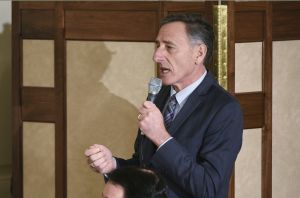
A handmade sign directs voters to a nearby polling place. (Photo by Jessica Kourkounis/Getty Images)
Following the April demonstrations in Washington for campaign finance and voting rights reform, BillMoyers.com has invited activists — some of whom participated in the protests and some who did not — to describe how they see momentum continuing on these issues. This essay on voting rights from the Brennan Center is part of that series.
At first glance, this does not seem a season of political hope: With the November election still months away, voters’ patience already is frayed by negative, exhausting nominating fights. Those who had the stomach to go to the polls faced, in some places, hours-long lines and other hiccups just to cast a ballot as new voting restrictions take effect across the country.
But breaking through the negativity comes encouraging news: Two weeks ago, Gov. Peter Shumlin signed a bipartisan bill making Vermont the fourth state in the country to enact automatic voter registration — a revolutionary policy that can help add millions of new voters nationwide. And it’s getting broad, bipartisan support.
With outdated voting systems causing problems and confusion at the polls, automatic registration offers a new way out of the voting wars, and a much-needed reprieve from the partisan bickering plaguing our political debate.
It’s a bright spot in a year that’s seen many localities making it harder for people to vote. In 2016, 17 states will have new voting restrictions in place for the first time in a presidential election. We’ve already seen their impact in the primaries. Wisconsin’s strict photo ID law made it harder for students to vote. North Carolina’s series of restrictions caused confusion on Election Day, and while a federal judge just upheld those restrictions, he also had to acknowledge how difficult it was for some voters to get the necessary ID.
Underfunded and antiquated voting systems have also wreaked havoc. Arizona severely cut polling places, leaving voters in five-hour lines. New York officials accidentally removed more than 100,000 voters from the rolls, and many more could not even participate because they did not change their party affiliation in time.
Whether you support Hillary Clinton or Donald Trump or Bernie Sanders, everyone can agree: We should all be able to go to the polls and cast a ballot for our candidate without major hold-ups.
Automatic voter registration can help fix this mess. Oregon and California led the way, passing bills in 2015. But this year, West Virginia and Vermont enacted new laws, this time with bipartisan, nearly unanimous legislative support — a welcome change in this era of sharply divided politics.
Under Vermont’s law, eligible citizens will be registered to vote when they visit DMV offices, unless they opt out. The DMV transfers the person’s information to the secretary of state’s office. If the person is eligible but unregistered, election officials register them to vote — simple as that.
Automatic registration boosts the security of our elections by making the voter rolls more accurate, which can reduce the kind of problems we saw with voting lists in New York. It cuts costs, something every elected official can support. And it also brings more new voters onto the rolls. Oregon put its new law in place in January, for example, and registration rates have already quadrupled.
These benefits explain why Vermont’s bill received nearly unanimous support from all three major parties represented in its legislature — Progressive Party member Chris Pearson authored the legislation, Democratic Secretary of State Jim Condos strongly advocated for it, and every Republican legislator but one supported it.
Similarly, West Virginia’s automatic registration bill, passed in March, received just a single “no” vote. Though some have suggested legislators adopted automatic registration only because it was added to a bill Republicans originally proposed to make West Virginia’s ID requirements for voting stricter, Republican leadership contends otherwise. Senate President Bill Cole, a Republican, stated that automatic registration can be “a great benefit to our citizens and will encourage more people to go to the polls.”
This recent success in Vermont is a reminder that even as voters face challenges and barriers to exercising their rights, reforms to make voting more convenient for those who are eligible are on the rise. For the fourth year in a row, bills to improve voting access outpace those to restrict it. And nationally, 28 states have considered automatic registration measures in 2016.
In a year when presidential politics are dividing us, Vermont’s united support for voting reform is a promising change. It should give all of us hope that despite the rhetoric, legislators can still act to make the voting process better for all eligible Americans.





